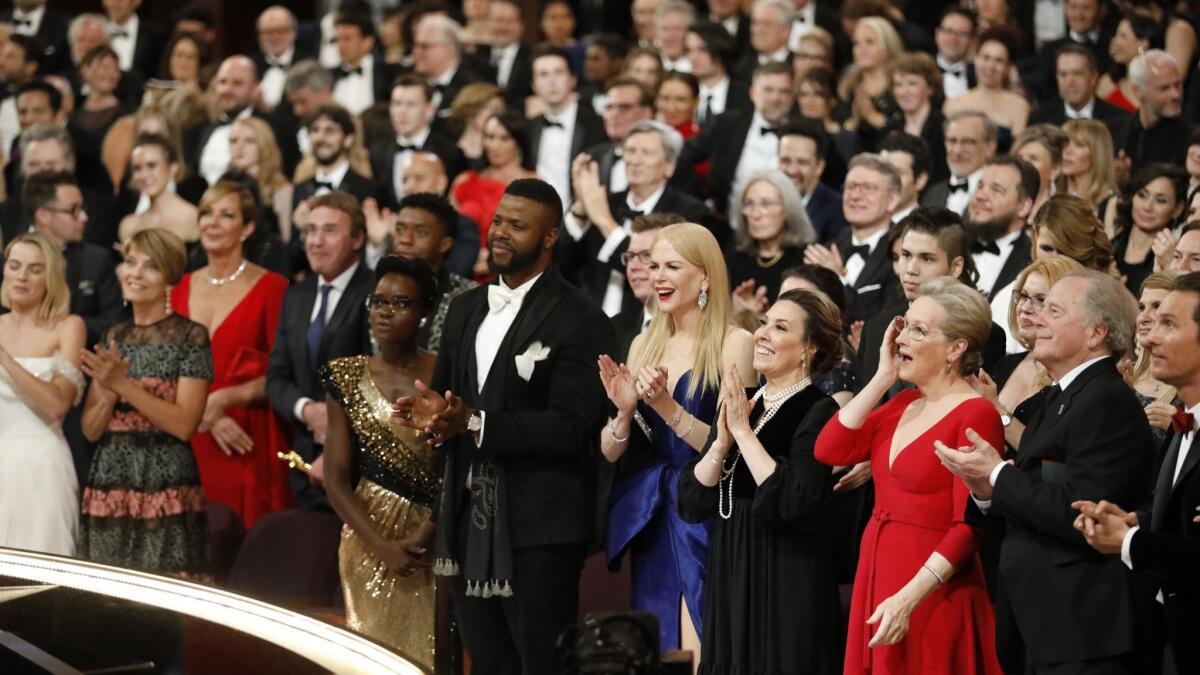Motion picture academy prepares to add new members as diversity push continues

On Monday, an elite group of film industry professionals around the world will receive Hollywood’s version of Willy Wonka’s golden ticket: an invitation to join the Academy of Motion Picture Arts and Sciences.
Exactly how many will get the coveted call to be part of moviedom’s most exclusive club remains to be seen. But if the last two years are any indication, it’s likely to be ... well, a lot.
Last year, the academy rolled out its red carpet to a whopping 774 new members — including such boldfaced names as Dwayne Johnson, Gal Gadot and Jordan Peele along with many more actors, filmmakers and below-the-line craftspeople whose names will never grace a multiplex marquee — topping the previous year’s record-setting class of 683 invitees.
With these back-to-back infusions of large numbers of new members, the academy took its first major steps toward its stated goal — announced in the wake of two years of #OscarsSoWhite controversies — of doubling the number of women and minorities in its historically overwhelmingly white and male ranks by 2020.
In decades past, few paid much attention to, or even were aware of, who was invited into the academy. Annual invitations were sent out quietly, and new classes were limited by quotas to generally closer to 100 invitees.
But as the academy has found itself at the center of hot-button debates over inclusion, representation and discrimination in the entertainment industry, who is — and who is not — a member has become a matter of increasing public scrutiny.
Last week, news emerged that basketball legend Kobe Bryant, who won an Oscar this year for the animated short “Dear Basketball,” had been denied an invitation to join the group. The decision was chalked up to the retired Lakers star’s lack of a larger body of film work. To many, though, the omission of Bryant — who faced sexual assault charges in 2003 that were ultimately dropped and later the subject of a civil settlement — had an extra layer of resonance in the context of the #MeToo movement and the academy’s subsequent enactment of new standards of conduct for its members.
As the 90-year-old institution has worked to remake itself under the increasingly bright glare of the spotlight, the annual revelation of the new class has become a bona fide media event, complete with a splashy website featuring graphs charting the academy’s progress toward its diversity goals.
Exactly how much progress has been made, though, depends on one’s perspective. In a landmark 2012 analysis, The Times reported that Oscar voters were 94% white and 77% male. With the two most recent classes, those numbers have shifted a few percentage points, with the academy’s ranks currently 87% white and 72% male.
In 2016, The Times estimated that the academy would need to add 85 people of color and 395 women to its ranks per year to reach its targets by the time the class of 2020 is announced..
In terms of boosting the number of minorities, the group is already well ahead of that pace. But the academy faces a steeper challenge in meeting its goals in terms of female membership, reflecting deeper inequities in an industry in which, according to a 2016 report by the USC Annenberg School for Communication and Journalism, directors are 97% male while women hold 21% of top executive positions.
To broaden the pool of possible candidates, the academy has intensified its international outreach, with last year’s class drawing from 57 countries around the world. “We really are committed to making this an organization for international artists,” academy CEO Dawn Hudson told The Times last year.
At the same time, the academy has also invited a number of people who have only recently come onto the scene or who may be better known for their work in TV than in film, leading some older rank-and-file members to worry that the standards for joining the group — which has swelled to more than 8,400 members — are being compromised in the pursuit of diversity.
“We have settled on numeric answers to the problem of inclusion, barely recognizing that this is the industry’s problem far, far more than it is the academy’s,” producer and former studio executive Bill Mechanic wrote in a scathing letter announcing his resignation from the group’s board of governors in April.
Despite such concerns, numerical breakdowns by race and gender are likely to be front and center once again in Monday’s announcement of the academy’s new class and in the analysis that follows.
But, in an interview last year with The Times, then-academy president Cheryl Boone Isaacs urged people to look beyond the graphs and pie charts at the invitees themselves and what they represent.
“This isn’t about numbers,” Boone Isaacs said. “This is about what is right. This is about recognizing who we all are and what we have to contribute to this art form.”
Twitter: @joshrottenberg
More to Read
Only good movies
Get the Indie Focus newsletter, Mark Olsen's weekly guide to the world of cinema.
You may occasionally receive promotional content from the Los Angeles Times.











